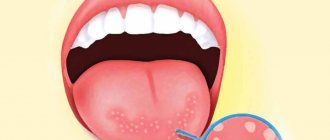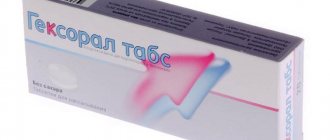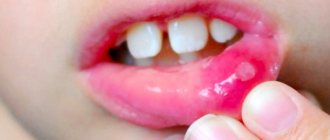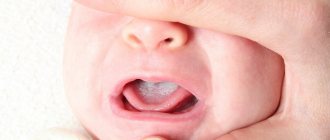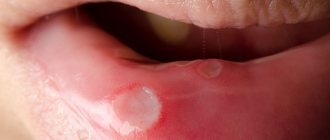Stomatitis is an inflammatory process of the oral mucosa, often of infectious or allergic origin. Stomatitis is one of the most common oral diseases in children of all ages, from infants to school-age children, although it can sometimes occur in adults. The special predisposition of children to this disease is explained by the fact that at a young age the mucous membrane of the oral cavity is more tender and thinner than in adults.
Types of stomatitis and causes of occurrence in children
The causes of stomatitis in children can be different, and they are directly related to the type of disease. In this section, we will look at the main types of stomatitis and their causes in children.
Herpetic viral stomatitis
This type of stomatitis is the most common and common. Sometimes this type of disease is simply called herpetic stomatitis or viral . Typically occurs in children aged 1 to 4 years.
Often infection occurs through airborne droplets. Infection with herpetic viral stomatitis is also possible through children's toys, dishes and other objects. Against the background of weak immunity, the virus enters the body and settles in the most damaged areas of the mucous membrane. Such places can serve, for example, as small wounds that appear after a child bites his lips.
Aphthous (allergic) stomatitis
This type of stomatitis is often also called drug stomatitis , since the main reason for the appearance of this type of disease is allergic reactions to various medications. It is impossible to say exactly which drugs can cause stomatitis; this is an individual predisposition, and can only be accurately determined by visiting a pediatric dentist after all the necessary diagnostics have been carried out. This type of disease occurs infrequently and, most often, in preschool children.
Traumatic stomatitis
As the name implies, this type of disease occurs after mechanical trauma to the child’s oral cavity and the entry of dirt and bacteria into these places.
Injuries can be of a completely different nature. This could be purely a dental problem. For example, due to an incorrect bite, a child may constantly bite his tongue or lips. Other types of mechanical damage to the mucous membrane include burns, for example, from food that is too hot, a pacifier that is too hard, various bad habits (pulling toys into the mouth, chewing a pencil, etc.).
Candidal (fungal) stomatitis
The main cause of candidal stomatitis is Candida fungi. Basically, this type of disease is typical for children under 1 year of age who are breastfed. Particles of mother's milk remaining in the baby's mouth after feeding provide an excellent environment for the development of this type of fungus. For this reason, sometimes this type of stomatitis is called thrush .
Infectious (microbial) stomatitis
The main reason for the appearance of infectious stomatitis in children is a decrease in immunity against the background of diseases such as tonsillitis, sinusitis, pneumonia and other diseases of the nasopharynx. This type of disease occurs in children of both school and preschool age. Infectious stomatitis develops especially often in the autumn-winter period, when the child’s immunity is weakened.
What is aphthous stomatitis
Often, infection of the oral mucosa is accompanied by the formation of ulcers (ulcers). Therefore, the disease is called aphthous, i.e. ulcerative stomatitis. The formation of ulcers begins with slight local redness of some areas of the mucosa, which then ulcerate with the formation of necrotic areas. Aphthae are painful, so the child becomes restless and irritable. The disease most often develops in childhood - 80% of all diagnosed cases. This type of stomatitis is not infectious and is not transmitted by contact.
Symptoms of stomatitis in children
Just like the causes of stomatitis in children, its symptoms are broad and also depend on the type of disease. In this section we will group the characteristic symptoms for each form of stomatitis in children.
Symptoms of viral stomatitis in children
The main symptom of viral (herpetic) stomatitis is the appearance of bubbles on the oral mucosa, which, after opening, form small erosions covered with plaque. Such erosions can be multiple in nature and located either at a distance from each other or merge together, forming large affected areas of the oral mucosa. They can be located on the lips, larynx, cheeks, tongue or roof of the mouth and are usually very painful and react strongly to touch, hot or cold food and other stimuli.
Symptoms of candidal stomatitis in children
Usually, before the onset of candidal stomatitis, the child experiences dryness of the oral mucosa, a burning sensation, an unpleasant taste and bad breath. Based on the baby's behavior, one can suspect the onset of the disease. As a rule, during this period, children are capricious while eating, behave restlessly, and sleep poorly. Further, as the disease develops, many small white dots appear, which form the affected area, covered with a white cheesy coating. In advanced forms of the disease, the plaque may turn gray. This indicates the transition of the disease to a severe form. In severe forms of candidal stomatitis, it is difficult to cleanse the mucous membrane of plaque and, at the slightest touch to the damaged area, it results in severe pain and bleeding.
Symptoms of bacterial (infectious) stomatitis in children
- The mucous membrane turns dark red; - The formation of yellow crusts occurs, which seem to stick together the lips; — The child experiences increased salivation; - Bad breath appears.
Also, depending on the infection that caused stomatitis, the following symptoms may be observed: the formation of fibrinous films, bleeding of damaged areas, severe plaque on the tongue.
Symptoms of aphthous stomatitis in children
With aphthous stomatitis, ulcers and aphthae form on the oral mucosa. Aphtha is a painful, round-shaped area of mucous membrane covered with fibrinous plaque. With aphthous stomatitis, children become lethargic, irritable, moody and complain of pain in the oral cavity. As a rule, aphthous stomatitis is chronic and can worsen 1–2 times a year.
Causes
Reasons for the development of the disease:
- weak immunity to viruses;
- thin mucous membrane with closely located blood vessels;
- insufficient oral hygiene measures.
Family Dentistry specialists note that the disease can be caused by buying an unsuitable toothbrush or new toothpaste, without the advice of a dentist, as well as staying in conditions of temperature changes.
How is childhood stomatitis treated?
After determining the nature of the disease, the doctor prescribes treatment. It goes in three directions:
Drug therapy. Medicines are prescribed taking into account the existing symptoms and type of stomatitis. The prescribed drugs are aimed at eliminating the causative agent of the disease and combating symptomatic manifestations - swelling, the appearance of mouth ulcers, pain and others.
Diet. The child is not given food that irritates the oral mucosa. Spicy, sweet, salty, sour - foods with these taste qualities are not recommended. A patient with stomatitis needs liquid or semi-liquid food that does not injure the mucous membrane.
Taking vitamins. Weakened immunity slows down the body's recovery during treatment. Strengthening with vitamin complexes promotes recovery and reduces the risk of recurrence of stomatitis.
Treatment of stomatitis in children
There is no single correct treatment for stomatitis in children. Treatment is selected individually for each child after visiting a pediatric dentist and greatly depends on the form of stomatitis. Depending on the type of disease, treatment may include both local and general therapy methods.
Despite the impossibility of selecting treatment for all types of stomatitis, there are a number of recommendations that should be followed for any form of the disease. During the course of the disease, it is recommended to adhere to a strict diet that excludes eating hot or too cold foods, as well as avoiding other foods that irritate the oral cavity. Particular attention must be paid to oral hygiene. After every meal, it is recommended to rinse your mouth. For rinsing, you can use special herbs or antiseptics.
When treating the viral form of stomatitis in children, various anesthetics and antiviral drugs, anti-inflammatory ointments and gels, and immunomodulating drugs are used topically.
To treat candidal stomatitis, it is necessary to create a certain alkaline environment in the oral cavity. This is achieved by lubricating the baby’s mouth with a solution of soda or boric acid. Pharmacies also have special antifungal solutions, such as Candide. It is recommended to lubricate after every meal.
In the treatment of bacterial stomatitis, as in the treatment of other infections, antibiotics are used. Self-administration of antibiotics is strictly prohibited. Antibiotics should be selected correctly and prescribed only by the pediatric dentist, based on the sensitivity of microorganisms to certain drugs.
When treating aphthous stomatitis, oral anesthesia is used with the help of anesthetic gels, and the mucous membrane is treated with antiseptic drugs. Phototherapy using ultraviolet rays is also used. At the same time, it is recommended to carry out general immunostimulating therapy with the help of special drugs and vitamins.
Return to list of services
Treatment
Therapy for stomatitis in children involves general rules that are mandatory for all types of the disease, and drug treatment aimed at eliminating the underlying cause.
Treatment should be prescribed by a pediatrician after examining the child, collecting the necessary information and identifying the causative agent of the infection.
General recommendations
General recommendations for treating stomatitis in young children include:
- Drink plenty of fluids (it is allowed to give the child unsweetened compotes and decoctions, but it is best to persuade the child to drink plain water).
- Regular ventilation.
- Air humidification in a children's room.
- Excluding refined and sweet foods from the child’s diet. If your baby is receiving complementary foods, you should avoid fruit purees made from sweet fruits (bananas) and cereals with added sugar.
- Medications depending on the type of stomatitis
For young children, lotions with chamomile decoction are used, which help relieve inflammation, have an antiseptic effect, and reduce pain.
Victoria Druzhikina
Neurologist, Therapist
Treatment of Herpetic stomatitis
Therapy for this type of disease is carried out in three stages:
- relieving irritation and eliminating the inflammatory process;
- healing of wounds formed after opening ulcers;
- fighting the virus and activating the body’s immune reserves.
To treat herpetic stomatitis in children under 3 years of age, antiseptic treatment of the oral cavity is used, after which antiviral medications are applied. Given the young age, rinsing with special infusions and solutions is excluded.
To treat the affected areas, you need to moisten a cotton swab with a solution of Furacilin (Rivanol) and gently wipe all the places where the rashes are localized. After this, you can begin applying ointments (for example, “Oxolinic” or “Interferon”) . The procedure is performed every three hours, unless a different treatment regimen is recommended by the pediatric dentist.
Doctor's advice
In the case of bacterial stomatitis, treatment with a solution of chlorhexidine bigluconate 0.05% is effective. If the child is small, then moisten the cotton wool, squeeze it out and wipe the affected area. Make sure that the drug does not flow from the cotton wool into the child’s throat. Processing is carried out 2-3 times per day. If the child knows how to rinse his mouth, then rinse 3-5 times a day. Hydrogen peroxide solution should not be used to avoid burns.
Victoria Druzhikina Neurologist, Therapist
When herpetic stomatitis is diagnosed in a child aged 1 year (or younger), parents do not always cope with antiseptic treatment measures. If it is not possible to treat the cavity with a tampon, you can purchase a special brush for young children (from 4 months), which is placed on the finger, wrap it in gauze and lubricate the affected areas.
Restoring immunity and fighting herpes viruses occurs with the help of medications (Arbidol, Acyclovir, Imudon). To heal wounds, you can lubricate them with sea buckthorn oil or rosehip oil.
Treatment of Candidal (fungal) stomatitis
Drugs with antifungal effects can only be prescribed to older children, so treatment of candidiasis in children under 3 years of age is predominantly local.
Newborn children can be prescribed medications such as Candide, Nystatin or Clotrimazole - these drugs are safe for children and can be used from the first days of a baby’s life.
In a clinic setting, a doctor may prescribe an irrigation procedure (irrigation of the oral cavity) using sodium bicarbonate in the form of a 2% solution, followed by treatment with sodium borate (10%).
An important condition is maintaining oral hygiene and regular treatment of lesions (plaque removal). This can be done using a soda solution (2 tablespoons of soda per mug of warm water). This procedure will help restore the alkaline environment, which is detrimental to yeast-like fungi. At home, it is recommended to repeat it at least 4-6 times.
Treatment of Bacterial Stomatitis
Treatment of bacterial stomatitis (often occurring at 2-3 years of age) is aimed at destroying bacteria that cause the development of the disease and deterioration of the baby’s well-being.
Severe cases require taking antibiotics, which are prescribed by a pediatrician after taking a smear to determine the causative agent of the disease and its sensitivity to various pharmacological groups of antibiotics.
For local treatment, you can use antibacterial sprays (Tantum Verde, Hexoral, etc.). Treatment must be combined with antiseptic treatment.
Allergic stomatitis
This type of stomatitis, in addition to hygiene measures, includes taking allergy medications and antihistamines (histamine blockers). Young children can use Tavegil or Suprastin for these purposes - both drugs are in drops.
Treating stomatitis in young children is not the easiest task, but it is quite feasible. To do this, you need to consult a doctor in time, follow his recommendations, monitor the baby’s nutrition and hygiene, and not make any changes to the treatment regimen on your own. The use of traditional methods should only be carried out with the permission of a doctor after examination and an accurate diagnosis.
To learn how to recognize and treat stomatitis in a child, watch the video:
This article has been verified by a current qualified physician, Victoria Druzhikina, and can be considered a reliable source of information for site users.
Bibliography
1. https://stgmu.ru/userfiles/depts/therapeutic_dentistry/Obyavleniya/stomatity_2013.pdf
Rate how useful the article was
5 Voted by 1 person, average rating 5
Did you like the article? Save it to your wall so you don’t lose it!
